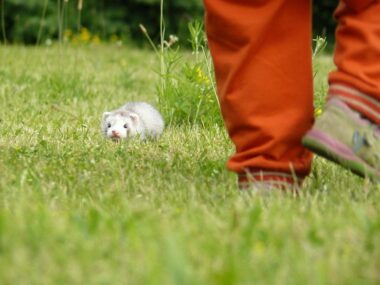Ferrets are wonderful furry additions for any family, and can be loving and loyal companions. Knowing the age of your ferret is crucial when it comes to knowing how to take care of them. An older ferret is also prone to certain health conditions, so you’ll know what to keep an eye out for, when you know your ferret’s age.
A ferret is a dimorphic creature. This means that their sex plays a role in the changes they experiences, as they grow older. A male ferret typically matures slightly faster when compared to the female. A male ferret is also slightly longer as well, although both sexes share the same height. This increase in length also makes male ferrets heavier than their female counterparts.
Ferrets can live anywhere between six to ten years. A six year old ferret is already considered old, and will need special care and attention.
How Do You Know What The Age Of Your Ferret Is?
Have you ever wondered, how to tell how old a ferret is? It can be difficult to tell the exact age of a ferret, even for pets. You’ll also need to take into account their gender, when accounting for their size. Despite this, there are various ways you can determine the answer to the question, how to tell how old a ferret is.
There are certain key areas you should be looking at, to determine the age of a ferret.
1. Using Their Teeth to Tell A Ferret’s Age
If you were wondering, how to tell how old a ferret is, then the simplest way is with the help of their teeth. When you take a ferret to a vet, they are also likely to use a ferret’s teeth to determine their age.
This is because the color and texture of a ferret’s teeth changes as they grow older. A young and healthy ferret, less than a year’s age, should have white unstained teeth. Their teeth should also be opaque. You’ll need to check the top two incisors inside a ferret’s mouth, to determine this.
How to Check a Ferret’s Teeth:
Hold your ferret by the scruff of their neck. This will make them open their mouth. Now, check the two incisors on the top row in their mouth. With time, these incisors will become stained yellow, and become more translucent as well. A common problem elderly ferrets experience, is gum and tooth decay. A few of their smaller teeth, especially from the bottom row, might fall out as well. A good way to ensure that a ferret’s teeth stay healthy for as long as possible, is to practice good dental hygiene on your pet.
2. Using Physical Changes to Tell The Age of a Ferret
Along with changes to their teeth, you may also find older ferrets losing both bone mass, as well as muscle tone. This means that they’ll no longer be as active as they used to be, in their youth. They may not run around and play as often, or try to climb things.
As your ferret grows older, it’ll become more and more difficult for them to keep up with the same pace of activity, as before. You may need to relocate their things, such as their bed, and their food and water bowl, to ground level.
Older ferrets can also experience hair loss. It’s usually the tail of a ferret that starts to lose hair at first, eventually growing bald. Due to this hair loss, your ferret can start to experience dry skin as well. The hair loss can also cause a lot of hairballs to form in your ferret’s throat.
Helping Your Ferret Through Their Physical Changes:
The solution to both these problems is very simple. If hairballs get stuck in your ferret’s throat, then consider giving them no more than half a teaspoon of coconut oil. This will help ease coughing and hacking associated with hairballs, while allowing the hair to pass through their system easily. You can also use the same coconut oil to give your ferret a nice oil massage from time to time. This helped soothe their dry skin, and helps them to feel relaxed as well.
With time, a ferret may also become hard of hearing, and may not share the same appetite that they had in their youth.
3. Using Behavioral Changes to Tell The Age of a Ferret
How a ferret behaves, can be an indication regarding what their age is. Younger ferrets tend to be more active, more playful, and enjoy playing games with their owners. You can find young ferrets to be full of energy, ready to play any game that you want to play. They also tend to have healthier appetites, love running and climbing, and are loving and compassionate with their owners.
A ferret’s behavior, as they age, can change slightly. They will continue to be loving and compassionate throughout their life, but they’ll also be more lethargic, feeling the need to sleep more often. Ferrets that have passed their prime often sleep a lot. But this can also be an indication that there’s an underlying health problem. Should you ever feel that your pet ferret is sick, remember to take them to the vet.
An older ferret eats less, sleeps more, and doesn’t run around and jump as much as they used to. They would much rather curl up on your lap and take a nap.
How to Tell How Old a Ferret Is: Their Lifespan

If you’ve wondered how to tell how old a ferret is, then the answer is that it can be quite difficult to tell the exact age of a ferret. Unless the pet shop you purchased your ferret from was able to provide you with the exact birth date of your ferret, you’ll need to work with an estimation.
1. From Birth to Four Months
A ferret that’s just been born, is known as a kit. A kit is usually deaf and blind, and take time to develop their senses the mother ferret weans her kits for a period that doesn’t exceed four months. Once the kits reach four months of age, the mother ferret starts the process of weaning them.
This is why a ferret is considered to be an adult, by the time they are four months old. This is also the time during which you’ll notice that your ferret has stopped growing. This is as four months is considered the time when a ferret has attained full maturity.
A healthy male ferret, that’s around four months old, should weigh between two to two and a half pounds. A healthy female ferret should weigh one to one and a half pounds.
Within the first two weeks since the kits were born, you’ll also be able to tell what their gender is. This is as after two weeks, male ferrets start growing much faster than female ferrets. Ultimately, a male ferret will also end up being longer in size as a result. Around this period in their lives, ferrets have white, healthy teeth. These teeth are opaque.
2. Between Four Months to Three Years
Although a ferret is considered mature by the time they’re four months old, it can take anywhere between an additional month, to three more months, for them to attain sexual maturity.
A ferret, up until the age of three years, is living through their healthy youthful years. Once a ferret turns four years old, they are considered old. Through this period of their lives, a ferret’s teeth can start to stain yellow. The ends of their teeth can start to become translucent as well.
3. Between Four Years to Ten Years
Ferrets usually live to six years of age, although in some cases, they can even live up to ten years. These are twilight years of a ferret’s life, and are marked with growing lethargy, falling hair and teeth, and an increase in the need to sleep.
An older ferret can also suffer from various health issues, such as arthritis. If you have an older ferret, you’ll notice that they no longer run around, or jump as much as they used to. If you were wondering how to tell how old a ferret is, then it’s easy to tell that a ferret is old, from their teeth. An old ferret will have yellow stained teeth, that’s translucent all the way to their gums.
If you have an older ferret, consider making all their items, such as their bed and toys, accessible to them at ground level.
Conclusion: How To Tell How Old Your Ferret Is
If you wanted to know the answer to the question, ‘how to tell how old your ferret is’, then this guide should be able to help you. The easiest way to tell a ferret’s age is with the help of their teeth. Younger ferrets have white opaque teeth, while older ferrets have yellow stained teeth that are often translucent.
The physical activity level of a ferret also plays a role in helping you to determine a ferret’s age. Younger ferrets are more playful, and love to run and jump. Older ferrets tend to sleep more, and are more lethargic in general.
With this, you should be able to tell a ferret’s age, any time you want to!







